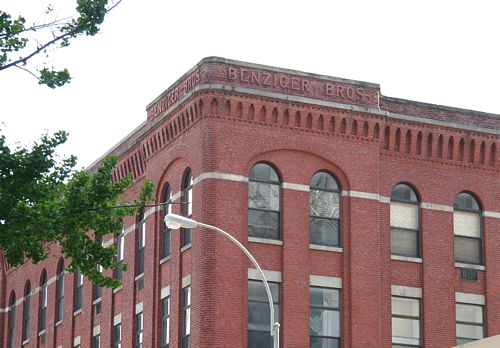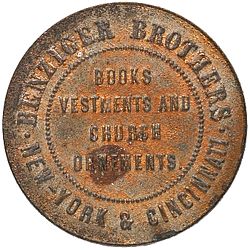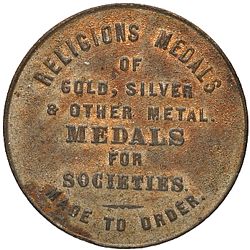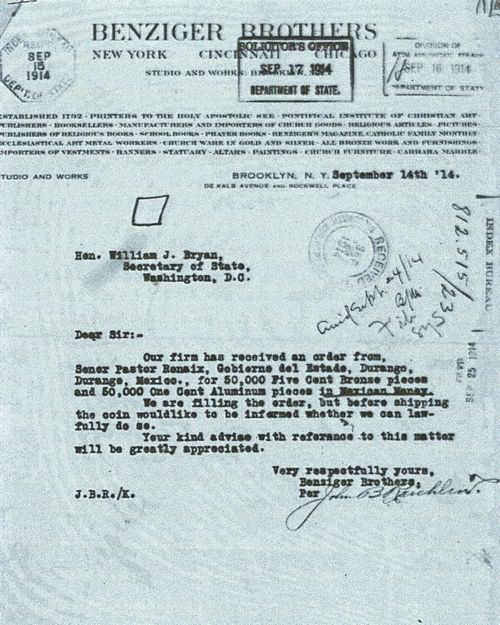The True History and Origin of the so-called 1914 Durango “Denver” 1 Centavo and 5 Centavos
by Scott Doll
Introduction
The 1914 Durango “Denver” 1 centavo and 5 centavos varieties were reportedly minted at the Denver Novelty Works Company in Denver, Colorado. This reference to Denver as the source of these coins has existed for many years and has been quoted in many numismatic references starting with Historical Notes on Coins of the Mexican Revolution 1913-1917 by Sanchez Garza in 1932Sanchez Garza, Historical Notes on Coins of the Mexican Revolution 1913-1917, translated by A. Frank, Mexico City, 1932 (available in the USMexNA online library). However, I have now identified a new player in the history of these coins - a company called Benziger Brothers from Brooklyn, New York.
New Analysis and Findings
In the records of the U.S. State Department are several letters from 1914 Records of the Department of State Relating to Internal Affairs of Mexico, 1910-1929, 812.515/23 and 24 that not only outline the company who was contracted to do the minting of these coins, but also list the individual who requested and authorized the minting, as well as provide details such as the mintage, metal composition and finally the approximate time period when the coins were minted.

Benziger Brothers, 94 De Kalb Ave. corner of Rockwell Place, Brooklyn, New York
Photo courtesy of Walter Grutchfield (waltergrutchfield.net)
The company that was contracted to perform the minting, Benziger Brothers, was a well-known firm in the United States at the time of the Mexican Revolution who specialized in English Catholic books, vestments, religious statues, and lithographs. They also produced religious medals of gold, silver and other metals, all made to order.


Photos courtesy of the American Numismatic Society
This undated advertising token made by Benziger Brothers highlighted their ability to produce coins and medals of quality either at their own factory or through other company relationships.

The first of the letters was sent from John B. Reichlin at Benziger Brothers in Brooklyn, New York on 14 September 1914 to William J. Bryan who was the U.S. Secretary of State from 1913-15 under Woodrow Wilson. The letter mentions that an order to mint the coins was received from “Senor Pastor Ronaix, Gobierno del Estado, Durango”. Benziger actually misspelled or simply misinterpreted the last name since the real name of the requestor was Pastor Rouaix who was the Provisional Governor of Durango at that time and served in that capacity from 4 July 1913 until 25 August 1914, when another revolutionary leader, Domingo Arrieta, forced his resignation. It is quite possible that Mr. Rouaix’s successor was not even aware of this agreement with Benziger to mint the coins, or if he was aware, he appears to have made no effort to cancel or modify the agreement. Benziger Brothers finally state that they are going to fulfill the order as requested by Mr. Rouaix, but would like to know whether they can lawfully ship the coins and would greatly appreciate their (Secretary of State) advice on this matter.
Important points from the letter are:
1. The Benziger Brothers letter was written on 14 September 1914. This specifically places the minting of these coins in the later portion of 1914 (September to December).
2. The order was requested by Pastor Rouaix in his official capacity as the Governor of the State of Durango; therefore this request came from the sanctioned government at that period of time during the Mexican Revolution.
3. The order requirements are very clear; “50,000 Five Cent Bronze pieces and 50,000 One Cent Aluminum pieces in Mexican Money”; therefore we now know the presumed mintage numbers and recommended metal composition for each coin.
4. Although the five centavos coins available on the market today are made of brass, not bronze, we do not know if Benziger Brothers or their designated subcontractor made the metal composition change with the approval from someone in the government in Durango. There are also reports of copper coins being struck which may have been pattern or early strike coins; however further research is needed since this assertion has not yet been fully substantiated.
5. The letter is addressed from the Benziger Brothers corporate offices and main factory located at De Kalb Avenue and Rockwell Place in Brooklyn, New York. Since Benziger does not state otherwise, one can assume that the minting of these coins could have taken place at this location. However, if they decided to subcontract this work to another company, they probably would not have mentioned it in this letter; therefore this letter does not provide conclusive evidence on the actual minting company and location.
The Department of State replied in a 24 September letter that they were “not aware of any law bearing on the matter referred to in your letter.” The Department of State also suggested that their inquiry be sent to the (U.S.) Treasury Department for their review. This letter was signed by Robert Lansing who was by this time the Acting Secretary of State following the resignation of William Jennings Bryan in mid-1914.
Although the Secretary of State letter suggested that Benziger Brothers contact the Secretary of the Treasury they had already done so. A third letter from the State Department to the Treasury Department on 10 October acknowledges correspondence and shows that the two Departments had reached the same conclusion.
Hypothesis and Conclusion
When you take into account all of the details from this, information obtained by Sanchez Garza in 1924 and lastly other historical information from that period, the most probable sequence of events now becomes much clearer. The following is a theory on what most likely happened.
- In early to mid-1914 Governor of Durango Pastor Rouaix or another government official representing Rouaix contacted Benziger Brothers in Brooklyn, New York with a desire to contract with them to mint 50,000 bronze 5 centavos and 50,000 aluminum 1 centavo coins.
- Sanchez Garza states in his publication that “it is probable that General Contreras placed this order”. This seems very doubtful since Pastor Rouaix was a very capable administrator and politician and as the Governor of Durango at this time appeared perfectly capable of handling this transaction. On the other hand, General Calixto Contreras was a revolutionary general and was probably much more concerned with the war raging all around him and not with the minting of small denomination coins in the United States.
- It is believed that Benziger Brothers then made the decision to subcontract the minting of the coins to the Denver Novelty Works in Denver, Colorado. Although Benziger was apparently capable of handling such an order, it was an order that was obviously not within their usual core business of religious publications and artifacts. They also could have selected Denver Novelty Works, not only due to their ability to handle such an order, but also due to their closer proximity to Durango compared to Brooklyn (approximately 1,300 miles vs. 2,500 miles).
- The theory that Denver Novelty Works handled most if not all of the minting of the coins is reinforced by the information obtained by Sanchez Garza in 1924 where he specifically mentions the coins were “coined in Denver, Colorado”; although the Denver Novelty Works was not mentioned by name, this was most likely the company involved.
- In August 1914 Pastor Rouaix was ousted as the Governor of Durango - something that Benziger Brothers and Denver Novelty Works were probably not aware of at the time. This is supported by the fact that the letter from Benziger Brothers in September 1914 still references Pastor Ronaix (Rouaix) as the requestor, not his successor or any other governmental authority from Durango.
- The coins were eventually minted in late 1914 once all of the correspondence questioning the legality was concluded in mid-October 1914 between Benziger Brothers, the (U.S.) Secretary of State and then eventually with the (U.S.) Secretary of the Treasury.
- According to Sanchez Garza, the five centavos coins could be found prior to the 1924 public auction which contained the vast majority of the minted coins; therefore it appears that several shipments of coins were sent to Durango and it was at least one of these shipments that eventually made it to Durango and allowed the coins to reach circulation. Due to the very large quantity of uncirculated coins on the market today, it seems logical that the circulated coins were a part of a smaller shipment sent to Durango and then the largest shipment was the one reported to have been diverted to Mexico City during the war and was then left unclaimed at the Mexico National Railways and eventually sold at auction in 1924.
The one thing that can now be emphasized is the fact that these coins not only have a history with Denver, Colorado, but also Brooklyn, New York. History will probably not be rewritten due to this information, however it does seem very reasonable and appropriate to do so and refer to them as Durango “Denver/Brooklyn” coins.
